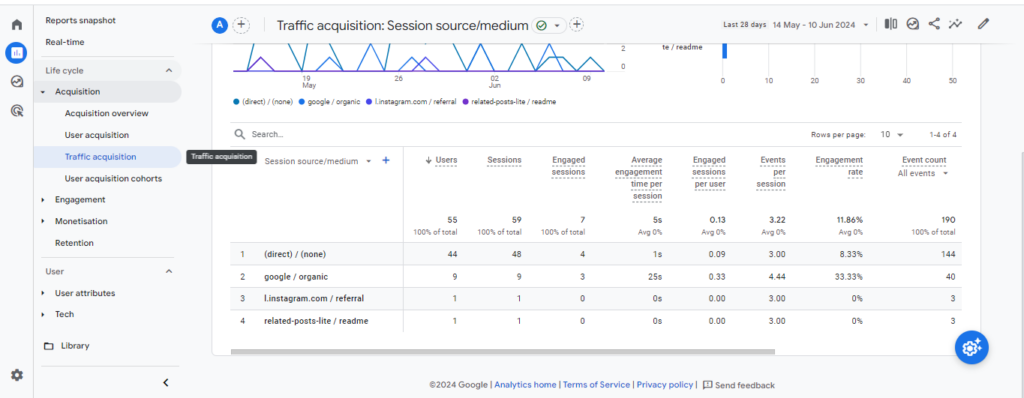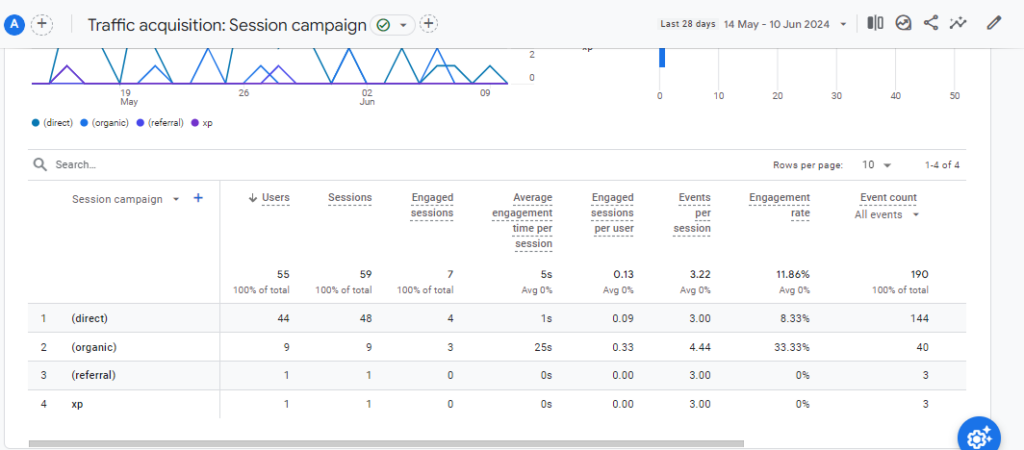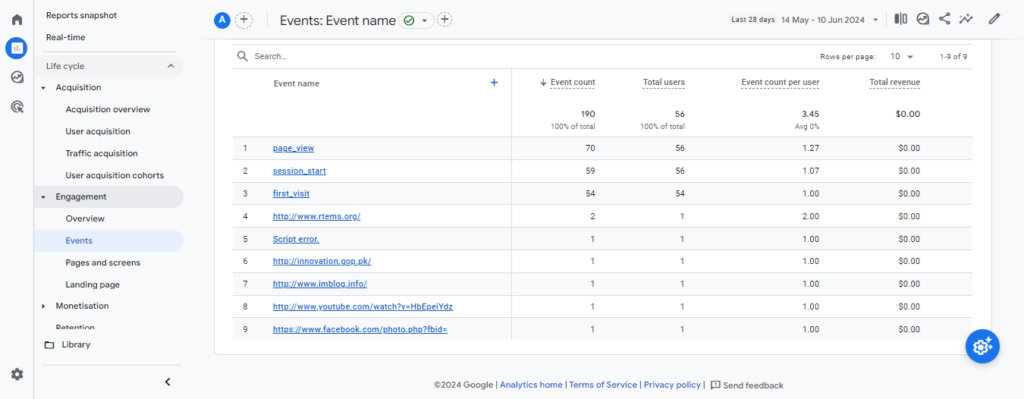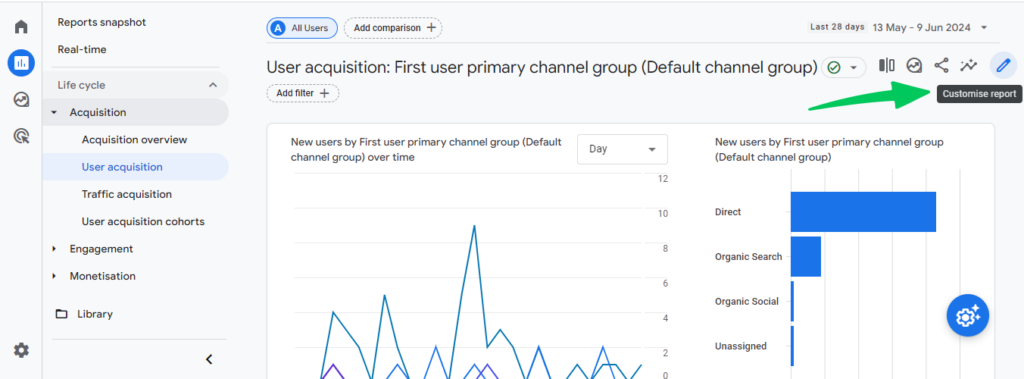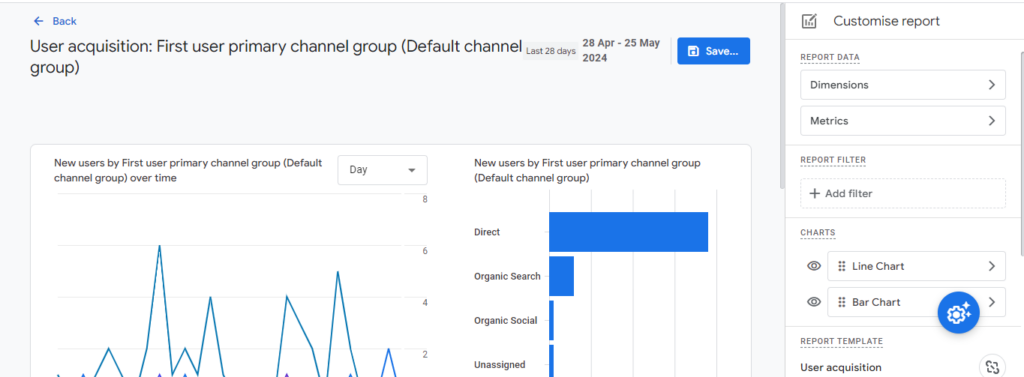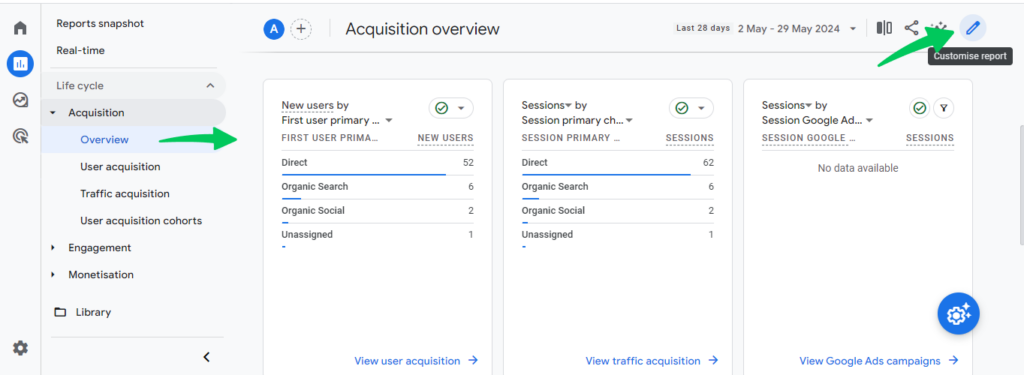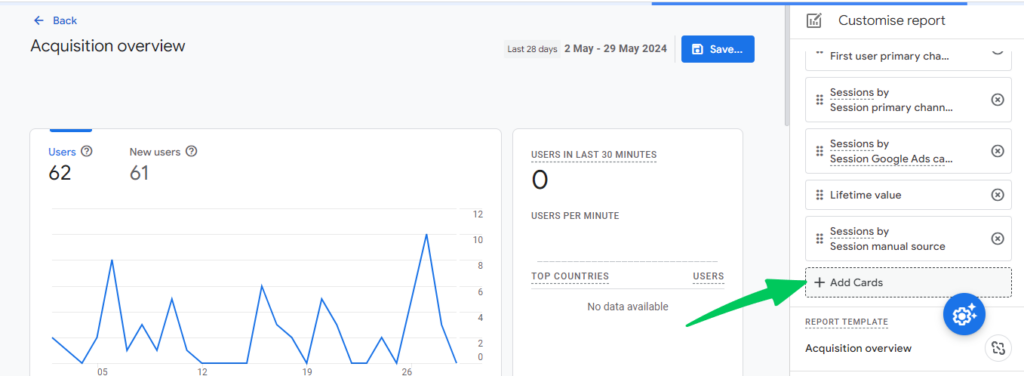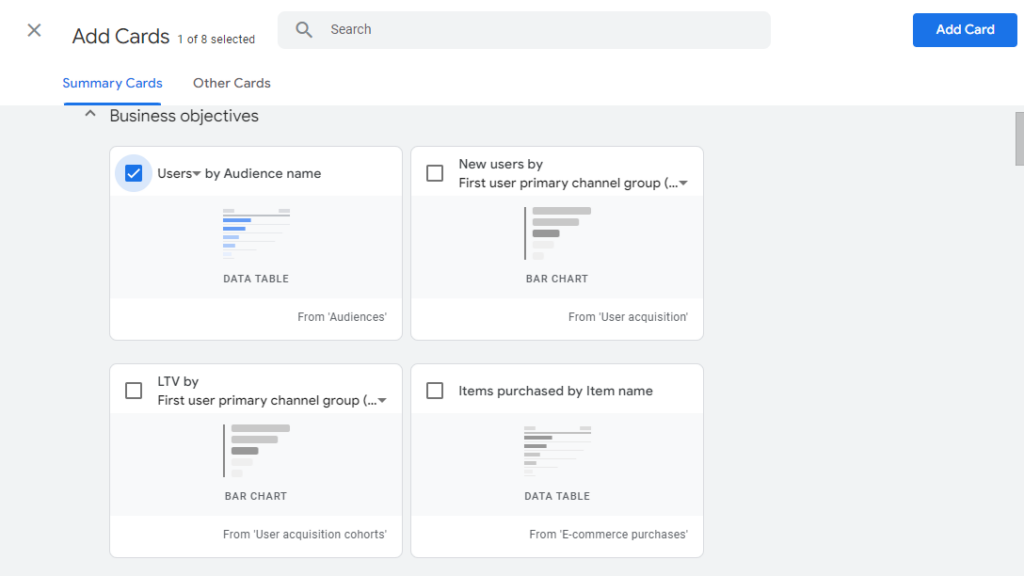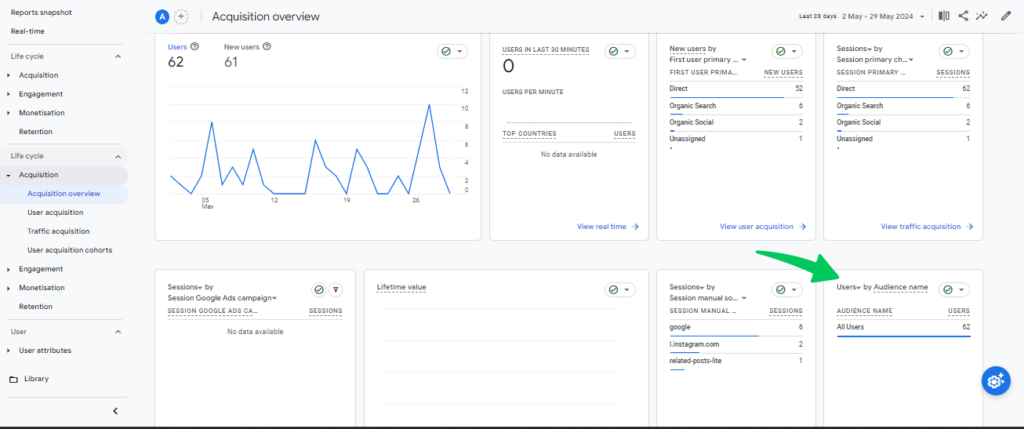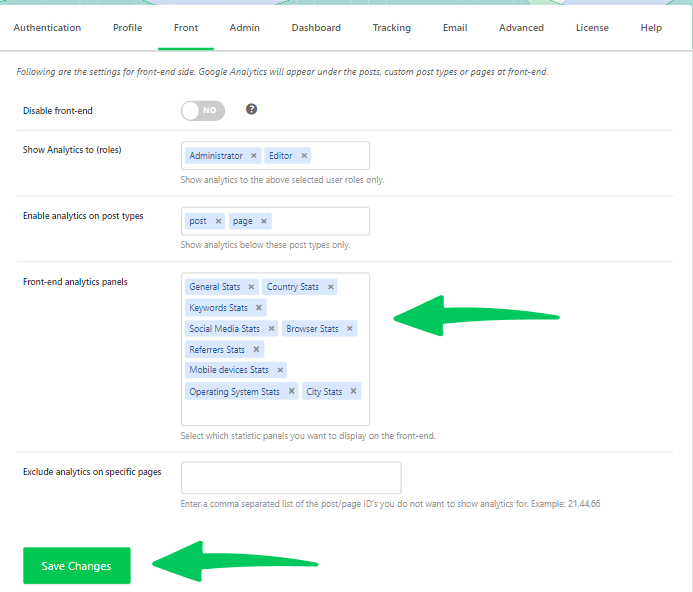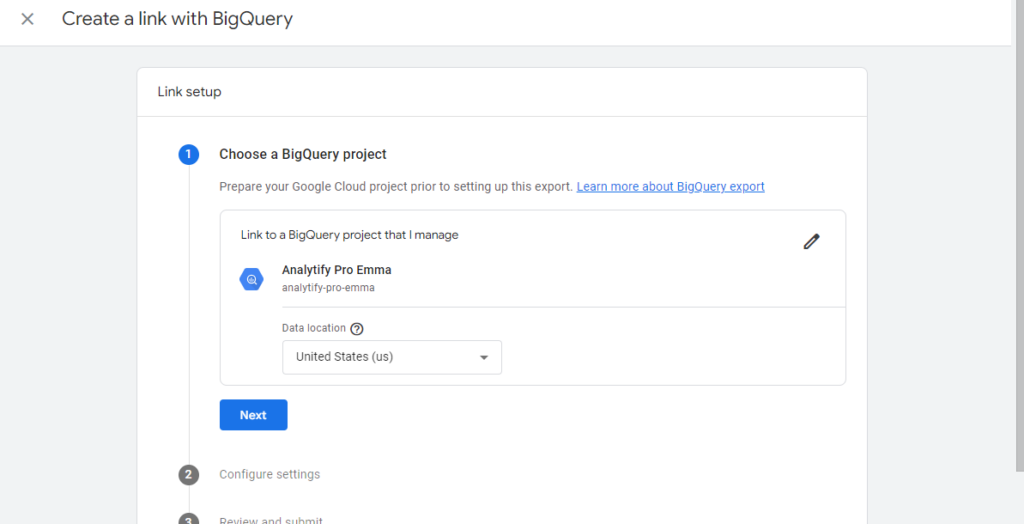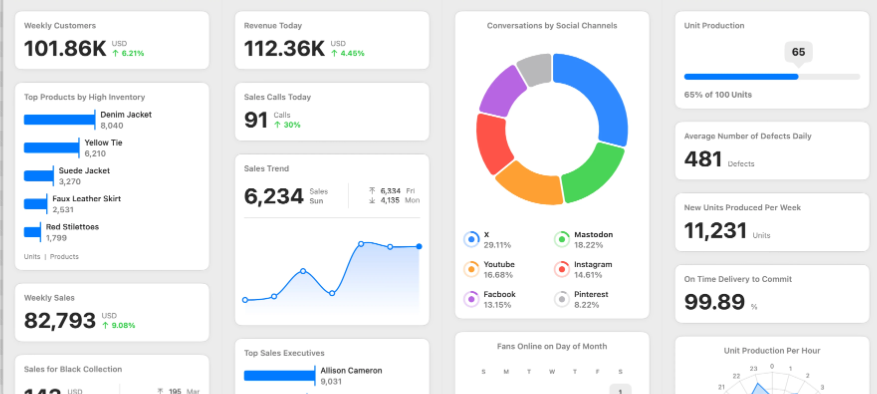
How to Create Google Analytics 4 (GA4) Dashboards
Do you want to know about GA4 dashboards?
Today, we’re covering everything you need to know about the Google Analytics custom dashboard.
Whether you’re a marketer, an analyst, or a business owner, understanding how to use the Google Analytics dashboard can transform your data analysis.
In this article, we’ll explore what GA4 dashboards are, why they’re important, and how to create customized ones. Plus, we’ll share some handy GA4 dashboard templates and examples to get you started.
So, let’s get started!
Google Analytics Dashboards (TOC):
What is a Google Analytics Dashboard?
Google Analytics dashboard provides a visual representation of your website or app’s data, making it easier to understand and analyze key metrics. Unlike previous versions, the GA4 dashboard offers enhanced capabilities and flexibility, allowing you to customize it to fit your specific needs.
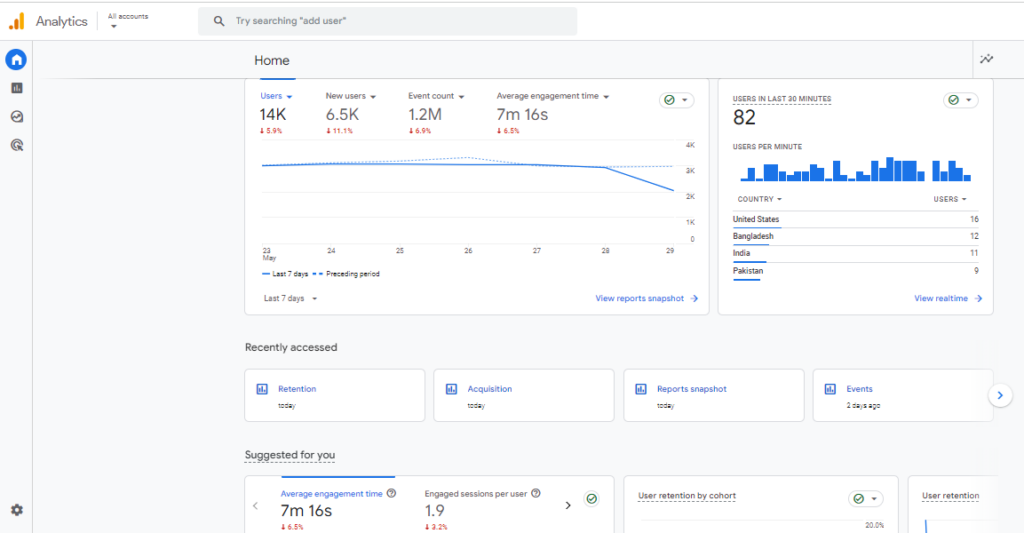
The Google Analytics dashboard tracks website traffic and provides real-time insights into audience, behavior, and acquisition. It allows users to measure site engagement, monitor campaign performance, and understand user demographics. The dashboard supports customization and can integrate with other Google services to enhance data analysis. It is essential for optimizing website performance and marketing strategies.
Understanding GA4 Dashboards
GA4 dashboards are customizable panels where you can display various widgets, each representing different data points such as user behavior, acquisition channels, and conversion rates. This customization is crucial because it lets you focus on the metrics that matter most to your business.

Here’s a simple breakdown of what makes GA4 dashboards unique:
- Customizable Widgets: You can tailor your dashboard with widgets that display the data you care about.
- Real-Time Data: You can get up-to-the-minute insights into how users interact with your site or app.
- User-Friendly Interface: Intuitive design makes it easy to create and adjust dashboards.
Google Analytics dashboards are designed to help you make sense of complex data, providing clear insights that can drive your decision-making process. Whether you’re tracking user engagement, monitoring marketing campaigns, or analyzing sales data, Google Analytics 4 Dashboards has you covered.
Advantages of Using a Google Analytics 4 Dashboard
Using Google Analytics 4 Dashboards offers numerous advantages, significantly enhancing your data analysis capabilities. Here are some key benefits:
Enhanced Data Visualization
GA4 dashboards provide an intuitive way to visualize data, making it easier to identify trends and patterns. You can quickly spot areas that need attention and make data-driven decisions.
Customization
One of the most significant advantages of GA4 dashboards is the ability to customize them according to your needs. Whether you need a GA4 dashboard template for quick setup or want to create a custom dashboard, there is flexibility.
Real-Time Reporting
With Google Analytics 4 Dashboards, you get real-time data updates. It means you can monitor user behavior and respond promptly to changes or trends.
Integration with Other Tools
GA4 dashboards seamlessly integrate with other Google products and third-party tools. This integration allows you to pull in data from various sources, providing a comprehensive view of your analytics.
Easy Sharing and Collaboration
Sharing insights with your team is straightforward with GA4 dashboards. You can easily export and share your dashboards, facilitating better collaboration and data-driven decision-making.
Here’s a quick list of these advantages:
| Advantage | Description |
| Enhanced Data Visualization | Intuitive visualization to identify trends and patterns |
| Customization | Ability to tailor dashboards to specific needs |
| Real-Time Reporting | Real-time data updates for timely decision-making |
| Integration with Other Tools | Seamless integration with Google products and third-party tools |
| Easy Sharing and Collaboration | Simplified sharing for better teamwork and insights |
Utilizing Google Analytics dashboards helps streamline your data analysis process, making it more efficient and effective. It can lead to better strategic decisions and improved business outcomes.
Learn how to properly set up GA4 referral exclusion to prevent payment gateways and third-party services from distorting your analytics data.
Important Metrics to Track in GA4 Dashboard
To make the most out of your GA4 dashboards, it’s essential to focus on the right metrics. These metrics provide valuable insights into various aspects of your website or app’s performance. Let’s explore some of the key metrics you can find in your GA4 dashboard:
User Metrics
User metrics help you understand who your visitors are and how they interact with your site. Key user metrics include:
- Active Users: The number of users who have interacted with your site or app within a specific timeframe.
- New Users: The count of first-time users during a selected period.
- Returning Users: Users who have visited your site previously.
Acquisition Metrics
These metrics show how visitors find your site. They can help you determine which marketing channels are most effective. Important acquisition metrics include:
- Campaign Performance: Metrics related to specific marketing campaigns.
Behavior Metrics
Behavior metrics provide insights into how users interact with your content. Key behavior metrics are:
- Pageviews: Total number of pages viewed.
- Events: Specific interactions on your site, such as clicks, video plays, or downloads.
- Average Session Duration: The average length of a user’s visit.
Conversion Metrics
Conversion metrics track how well your site meets its goals, such as sales or sign-ups. Essential conversion metrics include:
- Ecommerce Transactions: Total sales generated by your site.
- Conversion Rate: The percentage of visits that result in goal completions (e.g. a purchase or a file download).
- E-commerce Overview: Total Revenue, number of transactions, average order value and conversion rate.
Read about 10 important metrics you can track in GA4.
Here’s a table summarizing these metrics:
| Category | Metric | Description |
| User Metrics | Active Users | Number of users interacting with your site/app |
| New Users | Count of first-time users | |
| Returning Users | Users who have visited before | |
| Acquisition Metrics | Traffic Source/Medium | Origin of traffic (e.g., organic, direct, referral, paid) |
| Campaign Performance | Metrics related to marketing campaigns | |
| Behavior Metrics | Pageviews | Total number of pages viewed |
| Events | Specific interactions (clicks, plays, downloads) | |
| Average Session Duration | Average time of user visits | |
| Conversion Metrics | Goal Completions | Number of goal completions |
| Ecommerce Transactions | Total sales generated | |
| Conversion Rate | Percentage of visits resulting in goal completions |
For a more detailed look into these metrics, you can explore our in-depth guide on important Google Analytics metrics and how to enable IP anonymization in GA4 to ensure personal user data remains protected.
By focusing on these metrics, your Google Analytics custom dashboard will provide valuable insights, helping you to optimize your strategies and improve your overall performance.
How to Create GA4 Dashboards (4 Ways)
Creating GA4 dashboards is a straightforward process once you know the different methods available. Here, we’ll explore four effective ways to create your own Google Analytics 4 dashboards.
Google Analytics 4 Custom Dashboards
One of the easiest ways to create a custom dashboard in GA4 is by using the built-in customize reports option. This method allows you to tailor your dashboards to display the most relevant metrics for your business.
1. Log in to Google Analytics 4
First, log in to your Google Analytics 4 account. Navigate to the property you want to work with.
2. Access the Reports Section
Click the “Reports” section on the left-hand menu. This is where you can view and customize your reports and dashboards.
3. Customize Your Report
In the Reports section, go to any report and click “Customize Report” to start tailoring your dashboard.
Let’s suppose we go to Acquisition >> User acquisition and customize it.
You’ll see options to add various widgets and metrics.
4. Add Widgets
Select the metrics and dimensions you want to include in your dashboard. You can choose from various options like user, acquisition, and conversion metrics.
5. Arrange and Save
Arrange the widgets and save your custom dashboard by clicking Apply.
Following these steps, you can create a GA4 dashboard that displays all the critical metrics you need to effectively monitor your website or app’s performance.
6. Enhance Your Dashboard with Cards
- Choose Relevant Cards: Cards are visual elements like charts and graphs that display data.
You can add or remove these by navigating to a specific dashboard. Let’s suppose we edit cards for Acquisition >> Overview and click the pen button to edit.
- Customize Your Cards:
A drop-down menu of all the cards will appear, allowing you to customize them.
If you’re working on business branding, it helps to have a digital business card printing solution that complements your professional identity.
- Add and Remove Cards: You can easily add new cards by clicking “+ Add Cards” and remove unwanted ones by clicking the “x” next to each card.
Ensure you browse through both the “Summary Cards” and “Other Cards” to select the most suitable metrics for your needs when adding cards.
Let’s suppose you add Users by Audience name card. It’ll display in the relevant dashboard for which you selected this card as shown in the below screenshot:
Install Analytify on WordPress
Another efficient way to create GA4 dashboards is by using Analytify, a popular WordPress plugin that simplifies integrating Google Analytics into your WordPress site. Analytify offers a user-friendly interface and powerful features to help you make the most of your analytics data.
1. Install the Analytify Plugin
- Navigate to your WordPress dashboard.
- Go to Plugins >> Add New.
- Search for Analytify and click Install Now.
- Once installed, click Activate.
- Read How to Install and Activate Analytify.
2. Configure Settings
- Go to “Analytify” in your WordPress dashboard menu.
- Under Settings >> Admin configure various options, such as which user roles can access the analytics data.
You can decide which specific metrics you want to track.
3. Create Custom Dashboards
- Navigate to Analytify >> Dashboard.
- Here, you can customize your dashboards by selecting date ranges.
Advantages of Using Analytify
- Ease of Use: Analytify simplifies the process of adding Google Analytics to your WordPress site, making it accessible even for those with minimal technical expertise.
- Comprehensive Data: Get detailed insights directly from your WordPress dashboard, eliminating the need to log into Google Analytics separately.
- Customization: Tailor your dashboards to focus on the metrics that matter most to your business.
By using Analytify, you can create powerful Google Analytics custom dashboards that provide deep insights into your website’s performance, all within the familiar environment of your WordPress dashboard.
Next, we’ll cover creating GA4 dashboards using Looker Studio. Let me know if you’re ready for the next section or if any adjustments are needed!
Creating Dashboards in Looker Studio
Looker Studio (formerly known as Google Data Studio) is a robust tool for creating detailed and visually appealing GA4 dashboards. It allows for seamless integration with Google Analytics 4 and other data sources, providing a comprehensive platform for data visualization.
1. Log in to Looker Studio
- Go to Looker Studio and log in with your Google account.
2. Connect to Google Analytics 4
- Click on “Add Data” and select “Google Analytics.”
- Choose the GA4 property you want to connect to and click “Add.”
3. Share and Collaborate
- Click “Share” to invite team members or clients to view or edit the dashboard.
- Set permissions to control who can view or edit the report.
Integration: How Looker Studio Integrates with GA4
Looker Studio integrates seamlessly with Google Analytics 4, allowing you to pull in data directly from your GA4 property. This integration enables you to combine data from various sources, providing a holistic view of your analytics. Here’s how it works:
- Direct Connection: Looker Studio connects directly to your GA4 property, ensuring real-time data synchronization.
- Custom Metrics and Dimensions: Looker Studio allows you to create custom metrics and dimensions, which can enhance your ability to analyze specific aspects of your data.
- Blending Data: Combine data from GA4 with other sources, such as Google Ads, Search Console, and more, to get a complete picture of your marketing efforts.
Benefits of Using Looker Studio
- Visual Appeal: Looker Studio provides a wide range of visualization options to create attractive and informative dashboards.
- Flexibility: The ability to connect to multiple data sources and customize every aspect of your dashboard.
- Collaboration: Easy sharing and collaboration features to work with team members and stakeholders.
Using Looker Studio, you can build powerful Google Analytics custom dashboards that provide deep insights and help drive informed decision-making.
Next, we’ll cover creating GA4 dashboards using Google BigQuery. Let me know if you’re ready for the next section or if any adjustments are needed!
Google BigQuery for Advanced Data Analysis
Google BigQuery is a powerful data warehouse solution that allows you to perform advanced data analysis on large datasets. Integrating BigQuery with Google Analytics 4 enables you to run complex queries, analyze extensive datasets, and create detailed GA4 dashboards.
1. Set Up a Google Cloud Project
- Go to the Google Cloud Console.
- Create a new project or select an existing one.
2. Link Google Analytics 4 to BigQuery
- In your Google Analytics 4 property, go to Admin >> Products >> BigQuery Linking.
- Click “Link” and follow the prompts to link your GA4 property to BigQuery.
3. Export GA4 Data to BigQuery
- Configure the export settings to automatically send your GA4 data to BigQuery. This can include user interactions, events, and other analytics data.
4. Visualize Data in BigQuery Dashboards
- Use BigQuery’s integration with Looker Studio or other BI tools to create visual dashboards based on your query results.
- Connect BigQuery as a data source in Looker Studio and design your dashboard using the queried data.
Advantages: Why BigQuery is a Powerful Tool for Large Datasets
- Scalability: BigQuery can handle large datasets efficiently, making it ideal for big data analytics.
- Speed: BigQuery can run complex queries in seconds with its high-speed processing capabilities.
- Integration: Seamlessly integrates with Google Analytics 4 and other Google Cloud services.
- Cost-Efficiency: Pay only for the data you query, making it a cost-effective solution for data analysis.
- Advanced Analytics: Supports advanced analytics and machine learning models, providing deeper insights into your data.
- Custom Queries: Write custom SQL queries to extract specific insights.
- Integration with BI Tools: Easily connect to BI tools like Looker Studio for advanced visualization.
- Real-Time Data Processing: Analyze data in real-time for timely insights.
Using Google BigQuery, you can create highly detailed Google Analytics custom dashboards offering deep insights and robust data analysis capabilities, making it an indispensable tool for any data-driven organization.
GA4 Dashboards FAQ
What are GA4 dashboards?
GA4 dashboards are customizable visual panels in Google Analytics 4 that display various widgets representing different data points. They help you track and analyze key metrics related to your website or app’s performance.
How do I create a custom dashboard in GA4?
Creating a custom GA4 dashboard involves using the customize reports option within GA4. You can add various widgets, select specific metrics and dimensions, and arrange them to fit your needs. For detailed steps, refer to our Google Analytics 4 Custom Dashboards section.
What metrics should I track in my GA4 dashboard?
The metrics you should track depend on your business goals. Commonly tracked metrics include user engagement (active users, new users), acquisition (traffic source/medium, campaign performance), behavior (pageviews, events), and conversion (goal completions, ecommerce transactions). Check our section on Important Metrics for your GA4 Dashboard for more details.
Can I integrate GA4 dashboards with other tools?
Yes, GA4 dashboards can be integrated with various tools. You can use Looker Studio for advanced visualizations, Analytify for WordPress integration, and Google BigQuery for large-scale data analysis. Each of these tools provides unique features to enhance your analytics capabilities.
How often should I update my GA4 dashboards?
Updating your GA4 dashboards regularly is advisable to ensure the data remains relevant and accurate. Depending on your needs, this could be daily, weekly, or monthly. Regular updates help you stay on top of trends and make timely data-driven decisions.
Are GA4 dashboards free to use?
Yes, creating and using GA4 dashboards is free within Google Analytics 4. However, some advanced features or integrations, such as using BigQuery, may incur additional costs based on usage.
Final Thoughts
GA4 dashboards are vital for any business serious about leveraging data for strategic decisions. They provide customizable, real-time insights that help you understand user behavior, track marketing efforts, and measure conversions. By integrating with tools like Looker Studio and BigQuery, you can enhance these dashboards’ capabilities, making them even more powerful.
We’ve explored the essentials of GA4 dashboards, from understanding them to creating custom dashboards using various methods.
You may also like to read the Detailed Guide on Important Google Analytics Metrics to get deeper command over the Google Analytics dashboard.
What has your experience with the Google Analytics dashboard been like so far? Do you have any tips or best practices to share? We’d love to hear your thoughts in the comments below!


